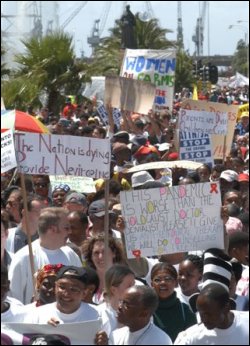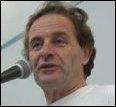Nowhere has the impact of HIV/AIDS been more visible than in South Africa. Today, more than 4.5 million of its inhabitants are HIV positive-the largest number of people living with HIV/AIDS in any one country. In Khayelitsha township, a poor area near Cape Town, Eric Goemaere, MD, head of MSF in South Africa, works with colleagues and local AIDS advocacy groups to bring antiretroviral (ARV) treatment to those who need it and to push the country's government to do much more.
|

|

Photo © MSF |
In May of this year, 200 patients attended the second anniversary celebration of the introduction of AIDS treatment in our clinics. As the patients and their doctors and nurses know, without treatment they probably would not have survived this long. They also know that the situation in Khayelitsha is unique. In South Africa, HIV is widespread, but access to life-extending treatment is rare.
Each day an estimated 600 people die of AIDS and 1,700 are infected with HIV in South Africa. The South African government has consistently refused to provide life-prolonging ARVs, despite the overwhelming success of this treatment in other countries. Recent government statements have demonstrated a sudden willingness to integrate treatment into the national AIDS protocol. Currently, each province is preparing a treatment plan. There is talk of providing treatment for half a million people by 2008. This would make South Africa's ARV treatment program the largest in the world.
Doctors Without Borders/Médecins Sans Frontières (MSF) has been working in Khayelitsha township since 1999. Here, most families live in corrugated iron shacks without running water or electricity. Unemployment is high, crime is rampant, and HIV prevalence is 25.5 percent in prenatal clinics.
Initially, we assisted with what was then the country's only government-supported project to prevent mother-to-child transmission of HIV. Now we provide care and treatment for HIV-positive clients in three HIV/AIDS clinics in Khayelitsha. Our doctors, nurses, and counselors see more than 1,800 clients a month, including more than 600 who receive ARVs. Of the latter, 72 are children. We have recently begun to provide care and treatment in the rural Eastern Cape province too, with the support of the Nelson Mandela Foundation. Our project was initiated to show that the use of ARVs in a primary health care setting, in a resource-poor African environment, is feasible and affordable. After more than two years of ARV treatment, this assumption has been indisputably demonstrated. Now, the number of patients on treatment must increase and the successes must be replicated in other communities and in larger numbers.
Three years ago, people chose to remain silent about HIV out of fear of the consequences of disclosing their status in an atmosphere where stigma and discrimination are widespread. We have seen firsthand how the link between the disease and imminent death can frighten people into silence. When we first arrived in Khayelitsha, everyone told us that our clinics would be empty. But the clinics have been flooded with patients almost from the day they opened. And, with treatment available and outspoken treatment activists educating the community, the stigma surrounding HIV has decreased significantly. In the last two years, we have seen ARV therapy both destroy the perception that HIV is fatal and break the silence.
The statistics speak for themselves, and the clients at the clinic can speak of the effect that their treatment has had on their CD4 counts and viral loads. They have seen the effects of the disease and witnessed their rapid clinical deterioration alongside a plummeting immune response. But now the patients are gaining weight and returning to normal activities. For the overwhelming majority, after only three months of treatment, the virus cannot be detected in their blood.
While the medical impact of the treatment has been dramatic, the social effects have been comparably impressive. People have embraced old strategies to challenge a new enemy. Here, the fight for treatment is the new "struggle." When people living with HIV found out there was a medicine that could save their lives and the lives of their families and friends, they demanded access to it. They proudly wore t-shirts emblazoned with the words "HIV POSITIVE," encouraging others to speak out.
The challenge now is to scale up treatment: treat thousands rather than hundreds, but maintain excellent outcomes.
In South Africa, there is some evidence that the government position on treatment is shifting from one of intransigence to one of collaboration and action. In August, the cabinet announced that the government must produce a treatment plan. But a treatment plan is only a start. Without ongoing political pressure from people living with AIDS, access to treatment will never be a reality for the poor. In the meantime, we will continue to support our South African colleagues as they demand to be treated with dignity, and with urgency.




